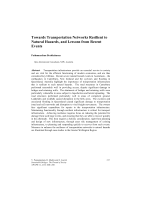Bridges

- Publication no: ABC-AAI006-11
- Published: 31 October 2011
- PDF (free) Download
Transportation infrastructure provide an essential service to society and are vital for the efficient functioning of modern economies, and are thus considered key lifelines. Recent severe natural hazard events in Australasia – the earthquakes in Canterbury, New Zealand and the cyclones and flooding in Queensland, Australia highlight the importance of transportation infrastructure that is resilient to such natural hazards. The road structures in Canterbury performed reasonably well in providing access, despite significant damage to bridges and retaining walls. The abutments of bridges and retaining walls were particularly vulnerable in areas subject to liquefaction and lateral spreading. The road structures performed particularly well in areas of competent ground. Landslides and rockfalls caused disruption in the hilly areas. The cyclones and associated flooding in Queensland caused significant damage to transportation (road and rail) networks and disruption to vital freight movements. The owners face significant expenditure for repairs to the transportation infrastructure. Maintaining functionality through resilient infrastructure is critical for transport infrastructure. Achieving resilience requires focus on reducing the potential for damage from such large events, and ensuring that they are able to recover quickly in the aftermath. This then requires a holistic consideration, right from planning and design of new infrastructure, through asset risk management of existing infrastructure, to planning and responding quickly to recover from such events. Measures to enhance the resilience of transportation networks to natural hazards are illustrated through case studies in the Greater Wellington Region.
